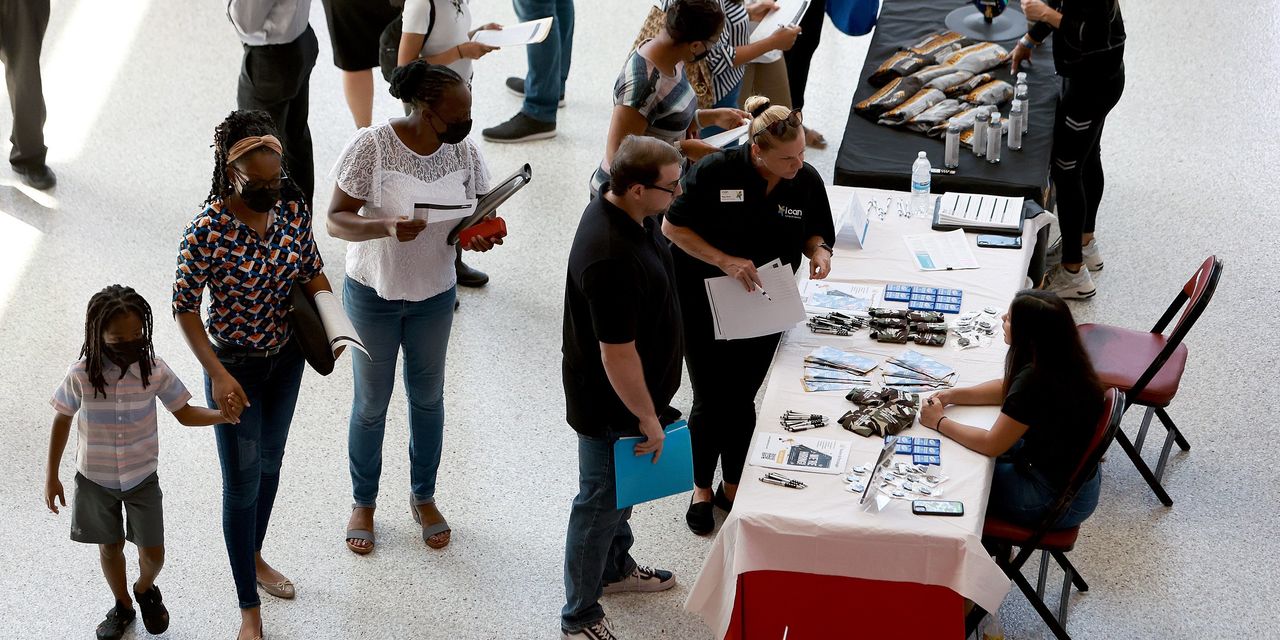When layoffs surged in the spring and summer, the U.S. economy showed early warning signs of recession. Except, it turns out, there was no surge in unemployment.
At the time, no one could be faulted for thinking the worse.
Looking back, the number of people applying for unemployment benefits jumped from a 54-year low of 166,000 in March to a nine-month high of 261,000 by July.
The increase in new claims was accompanied by a rising number of reported layoffs by companies such as Ford
F,
and Peloton
PTON,
Technology giants such as Facebook
META,
and Google
GOOG,
also signaled plans to reduce or even freeze hiring.
To top it off, the Federal Reserve had just raised a key U.S. interest rate for the first time since 2018 to try to slow the economy and squelch high inflation, a strategy bound to throw more people out of work.

People attend the Mega Job Fair in Florida, where hundreds of companies sought to fill thousands of open positions. Even though the U.S. economy has slowed, businesses are still hiring.
Joe Raedle/Getty Images
Typically a large increase in new jobless benefit claims in such a short period foreshadows a softening economy — if not outright recession.
The problem is, the government’s approach to calculating jobless claims got it wrong. There really wasn’t a big wave of people losing their jobs.
“The bigger picture here is the feared surge in layoffs earlier in the summer just didn’t happen,” said chief economist Ian Sheperson of Pantheon Macroeconomics.
What was to blame for the now-mysterious surge in new claims ? Turns out it was the government’s faulty formula for making so-called seasonal adjustments.
Say what?
A process gone wrong
We don’t want to bore readers with economic mumbo-jumbo, but stick with us.
The purpose of these adjustments is to eliminate the occasional freakish number in major economic reports and make it easier to figure out the real trends in the economy.
Take the annual surge in jobless claims in January, as seen in the accompanying chart. It happens every year as companies lay off temporary workers hired for the holiday shopping season.
Anyone looking at the surge in layoffs might think the economy is headed for trouble, but rarely is that the case. Typically layoffs soon subside.
Normally these adjustments are minor and no one really notices. But the coronavirus pandemic gummed up the works by the massive disruptions it caused to the economy in 2020 and 2021.
The result: Seasonal adjusted economic numbers can’t always be trusted now.
“The pandemic has made the seasonal adjustment process less efficient,” said lead U.S. economist Nancy Van Houten of Oxford Economics.
Why the summer spike?
Let’s go back to jobless claims. The real or actual number of people applying for unemployment benefits clung near historic lows through the spring and summer even as the seasonally adjusted figures showed mounting job losses.
Granted, there was a short-lived spike in actual jobless claims in July, but that’s easily explainable.
For years auto makers have briefly shut down assembly plants in July to retool them for new models. When that happens, auto workers are able to apply for temporary benefits.
The increase in July might also have reflected a spate of high-tech layoffs and lower long-term employment in education tied to the pandemic.
Whatever the case, the increase in jobless claims didn’t last. Since July actual claims have fallen to a 54-year low and touched the second lowest level on record.
Many businesses continue to hire, and even people who lost their jobs were able to find new ones pretty quickly in most cases.
“I just don’t think it was indicative of what was going on in the broader economy,” said Stephen Stanley, chief economist at Amherst Pierpont Securities.
Stay tuned, though. If the Fed really succeeds in slowing the economy through higher interest rates, layoffs and unemployment are all but certain to rise in earnest. It’s just a question of how much.
The Fed, for its part, predicts the nation’s unemployment rate will climb to 4.4% by next year from the current level of 3.7%.
If so, don’t be surprised if jobless claims climb toward 300,000 a week — or even surpass it.
x



